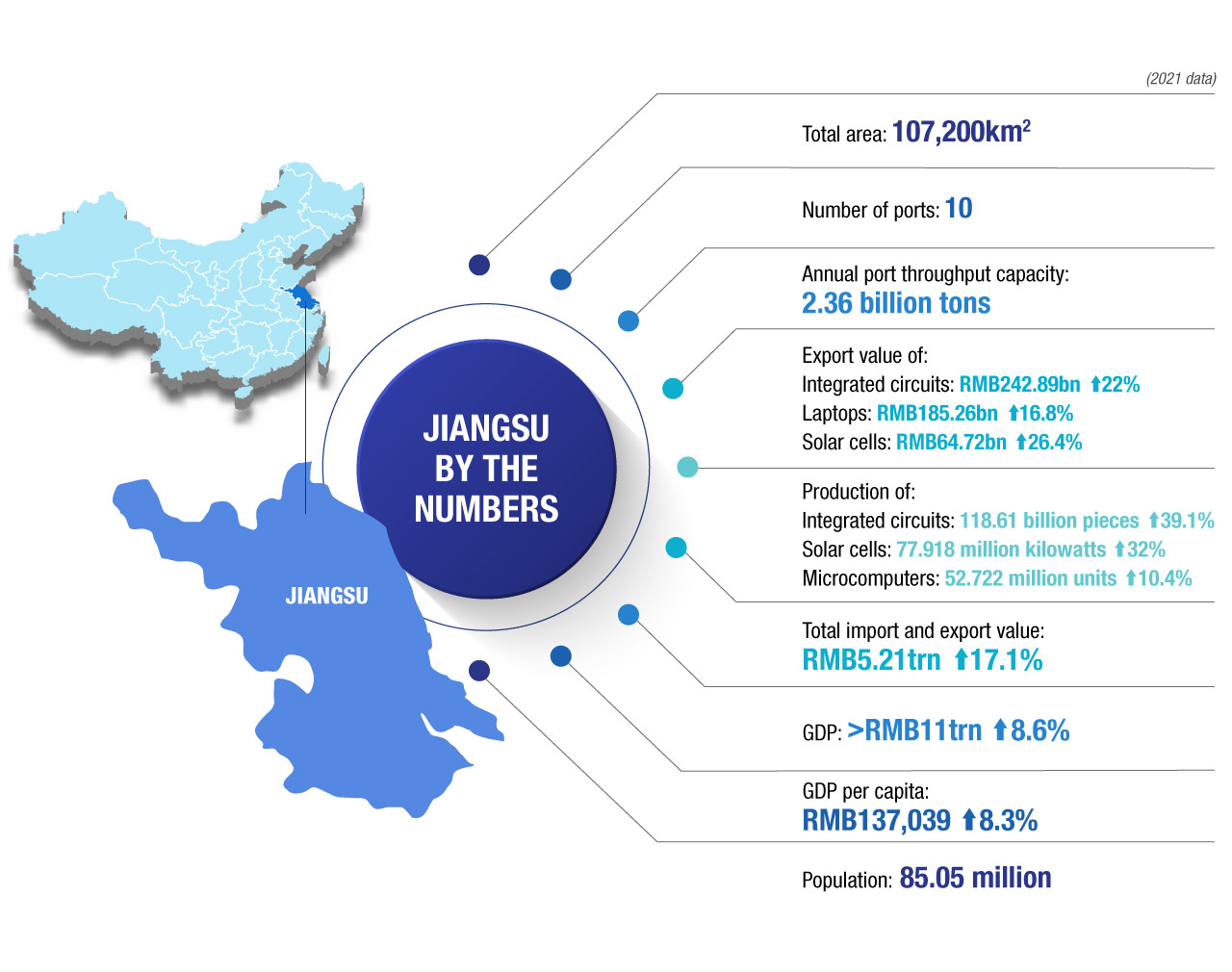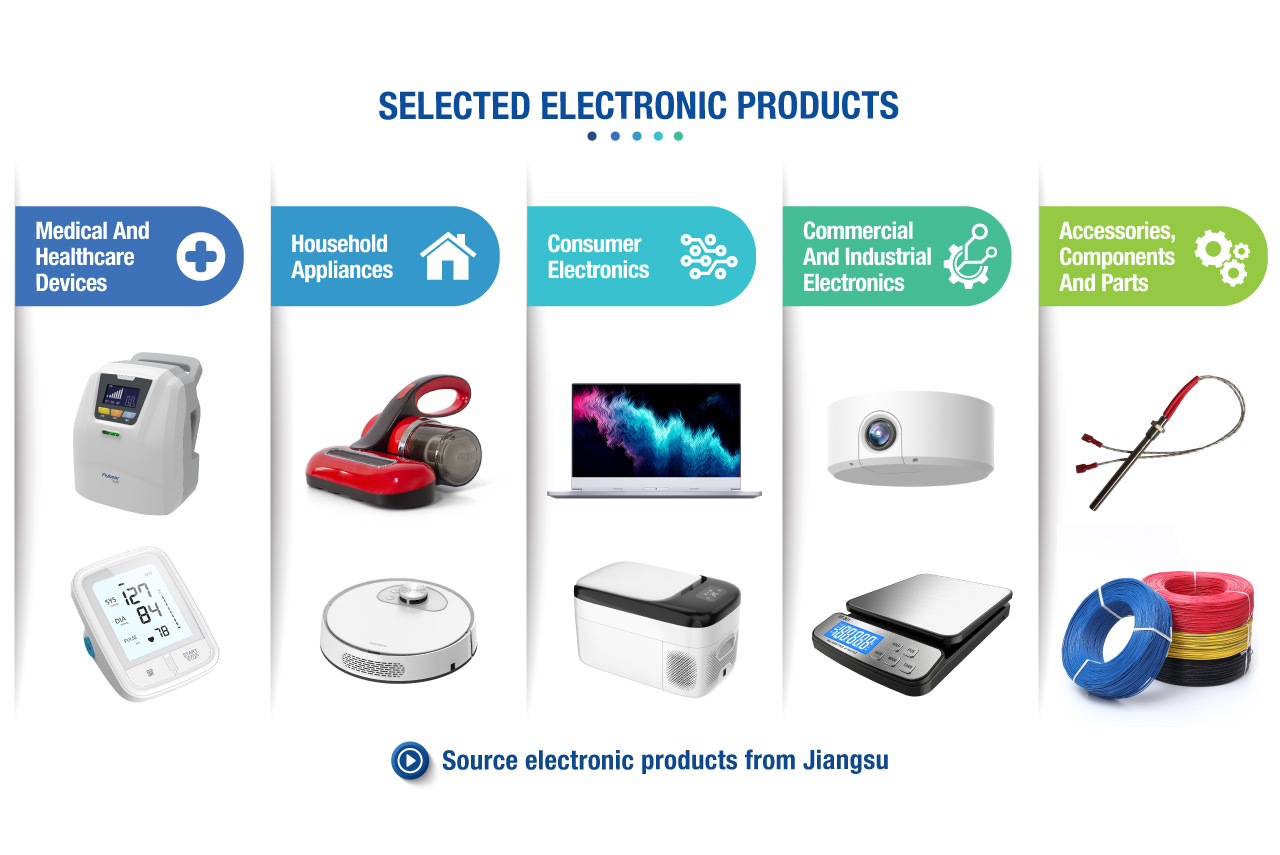The electronics industry is one of the pillar industries in Jiangsu Province. In recent years, the industry has been experiencing a rapid growth, including an enormous upsurge in product outputs and a wider variety of product categories, all of which have effectively driven the port province’s industrial export development.
Jiangsu Province, also known as “Su”, is located on the east coast of China with Nanjing as its capital. The province is situated close to the sea, which fosters a prosperous economy, well-developed education and splendid culture. With the Yangtze River and Huai River running through it, Jiangsu has a multitude of cultures and terrains. It has the Yellow Sea to its east and borders Shanghai and the provinces of Zhejiang, Anhui and Shandong.A land of water
With numerous lakes and rivers and adjacency to the sea, Jiangsu has a dense water network as 16.9 per cent of its total area is covered by water. It is the only province in the country to have access to long and large rivers, lakes and seas. The province has more than 20,000 waterways that are above the township level, 723 of which are listed as its main waterways. It has 12 lakes, each with an area of more than 50 square kilometres. Taihu Lake and Hongze Lake are over 1,000 square kilometres and are the third- and fourth-largest freshwater lakes in the country, respectively.Abundant natural resources
Jiangsu occupies a land area of 107,200 square kilometres, accounting for 1.12 per cent of the country. The province has 13 prefecture-level cities, 95 counties (including cities and districts) and 720 towns. As of the end of 2021, it registered a permanent population of 85.05 million.Located in the north–south climate transition zone, Jiangsu is blessed with favourable conditions for agriculture, earning itself the title of “a land of fish and rice”. As the first province in China to launch the development of provincial garden cities and ecological garden cities, currently, Jiangsu has nine national ecological garden cities, which accounts for 47 per cent of the country’s total (19). Jiangsu’s number of ecological garden cities ranks the highest in the country. In addition, Jiangsu has seven innovation bases for the implementation of ecological civilisation. More than 96 per cent of its urban parks are free for the public to visit. By 2025, 82 per cent of the public will be able to reach a park or a green space in 10 minutes and all parks will be free to visit.

Historical figures aplenty
Jiangsu has been famous for fostering outstanding and talented people. Many politicians, scholars and professionals have hailed from Jiangsu. Numerous classic Chinese literary works have been written in Jiangsu by literati and writers from past dynasties, including The Art of War by Sun Tzu, Water Margin by Shi Nai’an, Journey to the West by Wu Chengen, San Yan by Feng Menglong and Dream of the Red Chamber by Cao Xueqin.Profound heritage and culture
Jiangsu has fertile land, abundant produce and numerous local specialities. It has several world cultural heritages, including Suzhou Gardens, the Ming Xiaoling (the mausoleum of the Hongwu Emperor, founder of the Ming dynasty) and the Grand Chinese Canal. It also has a number of world intangible cultural heritages, including Kunqu (a form of Chinese opera), Guqin (a plucked seven-string Chinese musical instrument), engraving, papercutting and Yunjin (a traditional Chinese luxury silk brocade), as well as national intangible cultural heritages, including Suzhou embroidery, mud carving, jade carving and Xuzhou sachets. Nanjing salted duck, Suzhou Biluochun (a type of green tea), Zhenjiang fragrant vinegar and other local food showcase Jiangsu’s strong cultural offerings.A major port province
Jiangsu has 10 ports in the coastal areas along the Yangtze River and Yellow Sea. The province ranks first in the country in terms of its port throughput capacity, number of berths with 10,000-plus tons each, cargo throughput and number of ports with a capacity of 100 million tons each. There are 17 first-class ports in Jiangsu that have direct trade connection with ports in more than 100 countries and regions. It has 5,684 port berths with production capability, 524 berths above 10,000 tons and a comprehensive annual port throughput capacity of 2.29 billion tons.An open economy
In 2021, Jiangsu’s open economy maintained steady growth. The province’s GDP reached a new level of RMB11trn, an increase of 8.6 per cent and a 0.5 percentage point higher than the national growth rate. The added value of the manufacturing industry accounted for 35.8 per cent of the province’s GDP, which was the highest proportion in the country. The value of actually utilised foreign capital remained top of the country, with large-scale projects each with a value of more than US$30m accounted for over 60 per cent. The value of actually utilised foreign capital of the manufacturing industry accounted for 27 per cent of the country’s overall, while that of the service industry increased by 35.1 per cent year-on-year. The utilisation of foreign capital has improved in both quality and efficiency.Last year, 4,237 foreign-invested enterprises were newly established, an increase of 18.6 per cent over the previous year. The value of actually utilised foreign capital amounted to US$28.85bn, an increase of 22.7 per cent. A total of 726 outward investment projects were newly approved and China’s contracted foreign investment reached US$6.68bn. The value of newly signed foreign contracted projects was US$5.59bn, and the turnover of newly signed foreign contracted projects was US$5.95bn. Jiangsu has accelerated the construction of confluence points of the Belt and Road Initiative. A total of 191 new foreign-invested projects along the routes were in operation and China’s contracted foreign investment amounted to US$1.59bn.
Competitive edge of the Jiangsu electronics industry
The electronics industry is one of the pillar industries in Jiangsu. With the rapid rise of the industry in recent years, Jiangsu has been moving towards developing hi-tech products. It has also become an important manufacturing base for electronics and established many famous brands.Since China’s reform and opening up, Jiangsu’s electronics industry has advanced rapidly, with its product outputs soared and product categories progressively enriched. Over the years, the outputs of electronics (such as refrigerators, air conditioners, laptops, digital cameras and mobile phones) and other emerging products (such as solar cells and industrial robots) have not just been realised but experienced tremendous growth. Meanwhile, the province’s production volume of electronic product accessories is equally impressive. The production volume of electronic components, such as integrated circuits and electronic components, accounts for up to 30 per cent of the country’s total.
The rapid growth of the production outputs of major industrial products, including computers, communications equipment and other electronic equipment, has made major contributions to and effectively driven the province’s industrial export development. In 2021, Jiangsu’s import and export value recorded a year-on-year increase of 17.1 per cent to reach RMB5.21trn, which accounted for a record-breaking 13.3 per cent of the country’s total. The export value of Jiangsu-made integrated circuits, laptops and solar cells reached RMB242.89bn (grew 22 per cent), RMB185.26bn (grew 16.8 per cent) and RMB64.72bn (grew 26.4 per cent), respectively.
Jiangsu is China’s leading electronics manufacturing base. Each of its cities has its niche, industrial foundation and a relatively complete industry chain. Here to profile five Jiangsu cities:
- Nanjing — Nanjing is building an integrated circuit industry landmark that aims to have a global influence. The “City of Chips” will be the core in the layout of the city’s integrated circuit industry. As a traditional competitive industry in Nanjing, the electronic information industry is also developing rapidly. In 2021, the industry had an output value of RMB295.6bn, a year-on-year increase of 18 per cent. As an area of aggregation for the integrated circuit industry, the Nanjing Jiangbei New District has already gathered more than 400 companies related to the industry chain.
- Kunshan — Its electronic information industry was the first billion-dollar industry in Suzhou (a prefecture-level city of Jiangsu that administers Kunshan). Kunshan has become a manufacturing base with a global influence for electronic information equipment. In 2021, the output value of the electronic information industry reached RMB554.62bn, accounting for 53.9 per cent of the gross industrial output of industry above designated size and 47.7 per cent of Suzhou’s related output value. As an important carrier for the development of the new display industry in Kunshan, the national Kunshan Optoelectronics Industrial Park has become a leading display panel manufacturing base in the country.
- Wuxi — The Wuxi National Hi-tech Industrial Development Zone is of crucial importance in relation to the development of the integrated circuit industry in Wuxi. The zone is one of eight major bases approved by the Ministry of Science and Technology of the People’s Republic of China for the industrialisation of integrated circuit designs. It has been approved as a National Microelectronics Hi-tech Industrial Base and a National Innovation and Entrepreneurship Base for Integrated Circuits. It is home to three dedicated parks for integrated circuits, namely the National Integrated Circuit Design Park, Information Industry Technology Park and Integrated Circuit Industrial Park.
- Changzhou — The new Electronic Component Industrial Base at Changzhou’s Wujin Hi-tech Zone is an Industry Demonstration Base for New Industrialisation in Jiangsu Province. Thanks to its rapid development, the new electronic component industry has become one of five pillar industries of the zone and formed a relatively complete industry chain and scale of development. The products are mainly used in aerospace, computers, communications, home appliances and automobiles.
- Taizhou — The Taizhou Electronic Information Industrial Park is an important carrier for the development of the electronic information industry in Taizhou. As a key emerging industry of the city, its direction of development mainly relies on utilising export processing zones and microelectronics industrial parks to build an industry cluster.

